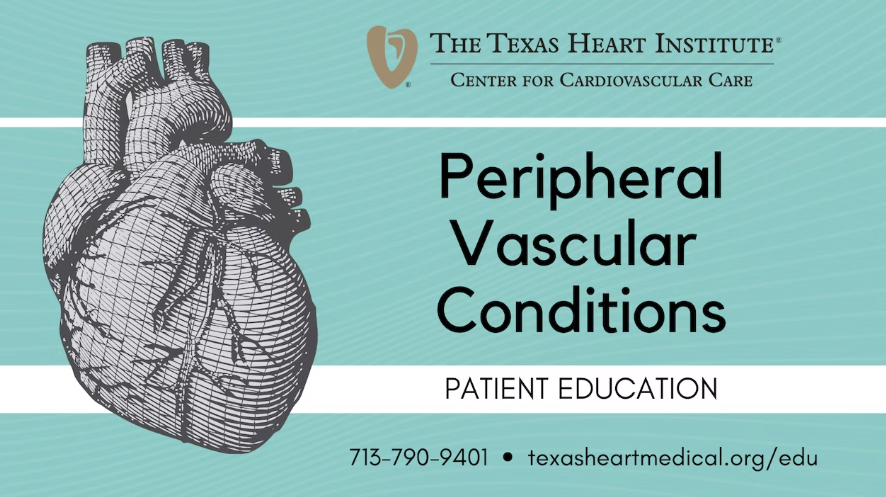
Peripheral Vascular & Aortic Aneurysm Program
Learn more about peripheral vascular disease conditions, diagnostics, and treatments: Watch Videos
Schedule an Appointment
Peripheral Vascular Disease
Peripheral arteries and veins transport blood to your arms and legs, and to the organs in and below your stomach. Peripheral vascular disease (PVD) damages or blocks these arteries and veins, causing swelling and in some cases blood clots. If only arteries are affected, it is called peripheral artery disease (PAD).
Artery diseases may result in:
Arterial blockage (including peripheral artery disease, or PAD) – Caused by plaque (a waxy substance) forming in the arteries—a condition known as atherosclerosis. This plaque may build up until it slows or blocks blood flow in the affected artery, depriving some of your body’s cells of oxygen. Clogged arteries may cause leg pain or cramps. This plaque build-up is caused by smoking, diabetes, high blood pressure, and high cholesterol.
Peripheral arterial aneurysms – Abnormal dilations of the peripheral arteries are caused by the weakening of the arterial wall. Aneurysms can occur in any artery. The most common and significant are abdominal aortic and thoracic aortic aneurysms. See Abdominal Aortic Aneurysms
Buerger’s disease – A rare disorder related to smoking. It causes the small and medium-sized arteries or veins in your feet and legs to tighten, making themselves narrower and restricting the flow of blood through them. This can lead to a lack of oxygen to the cells (ischemia) or tissue death (necrosis). Buerger’s disease is most commonly found in male smokers who are 20-40 years old. Its symptoms are tender, swollen areas over the vessels, cold hands and feet, and pain during walking. In the most severe cases, fingers and toes may need to be amputated. Smoking must stop immediately, and then circulation will improve.
Raynaud’s phenomenon – A circulation disorder that makes arteries in the fingers and toes (in some cases to the ears, nose, knees or nipples) spasm in response to smoking, stress, or cold temperatures. The cause is generally unknown but may be related to connective tissue disease, trauma, or diseases of the glands or central nervous system. Raynaud’s phenomenon is most commonly found in women. The symptoms include pale or blue skin that turns red later, numbness, and tingling in the fingers and toes. Warming the fingers and toes will typically help. Avoiding triggers, primarily cold, can reduce the spasms that lead to symptoms. Other measures may be needed, like pain relievers, calcium channel blockers, quitting smoking, and avoiding cold and stressful situations.
Vein diseases may result in:
Venous blood clots – Occurring in over 6 million Americans every year, blood clots in veins can be life-threatening if the clot breaks loose from the vein and lodges in the lungs, causing a pulmonary embolism (see below). Watch Video
Pulmonary embolism – Caused by a blood clot (pulmonary embolus) that dislodges from its vein source and moves to your lungs. It is very dangerous because it may have no symptoms but can lead to sudden death. If symptoms do occur, they are usually chest pain (especially when you inhale), shortness of breath, coughing up blood, dizziness, and fainting. If you have any of these symptoms call your doctor.
Phlebitis – There are 2 types of phlebitis:
Superficial phlebitis – Swelling of a vein near the surface of the skin, commonly in the leg. Typically the area along the course of the vein becomes reddish and painful. Superficial phlebitis is due to inflammation but in some cases could be accompanied by blood clots or infection. For this reason, is recommended to seek medical advice. Superficial phlebitis is easily treated with moist heat or anti-inflammatory medicines.
Deep phlebitis – Swelling of a deeper and larger vein inside the leg. It is less common than superficial phlebitis but is more dangerous and painful. Deep phlebitis can cause fever and may lead to blood clots in the veins. A serious complication from this condition is if the blood clot breaks off and travels to the lungs. Treatment may vary depending on the severity, but typically blood-thinning (anticoagulant) medicine is indicated. This condition could become life-threatening and requires medical attention. Watch Video
Varicose veins – Appears as swollen, purple veins under your skin. It can be caused by blood vessel damage or slow blood flow, or it can happen because the normal valves in your veins are damaged or missing. Without valves, blood may collect and cause the veins to bulge. Varicose veins are more common in women than in men and may be hereditary. They are commonly found in pregnant women because of hormonal changes and the extra pressure on the lower stomach. Obesity and excessive standing may also contribute to the formation of varicose veins.
Download & Print
Aortic Aneurysm Program
For over 25 years, our experts have led the refinement of percutaneous endovascular aortic repair (PEVAR) and have performed thousands of successful procedures.
An abdominal aortic aneurysm (AAA) is a disease that may not cause symptoms until it has progressed to a dangerous degree. Aneurysms form when the wall of the artery weakens and bulges outward. This condition can become life-threatening if the aneurysm grows large enough to rupture, resulting in massive internal bleeding. Since the aorta is the largest artery in the body, patients with a ruptured aortic aneurysm have an 80-90% risk of immediate death.
In 1996, Dr. Zvonimir Krajcer conducted the world‘s first percutaneous abdominal aortic aneurysm repair in a cardiac catheterization lab under conscious sedation and local anesthesia, and he continues to pioneer several lifesaving treatments for aortic aneurysm patients today. The recovery time after these minimally invasive procedures is shorter than after traditional open surgery for an aortic aneurysm.
Our doctors evaluate each patient carefully to determine the best and safest approach.

Dr. Zvonimir Krajcer tackles topics related to peripheral vascular disease conditions, diagnostics, and treatments:
